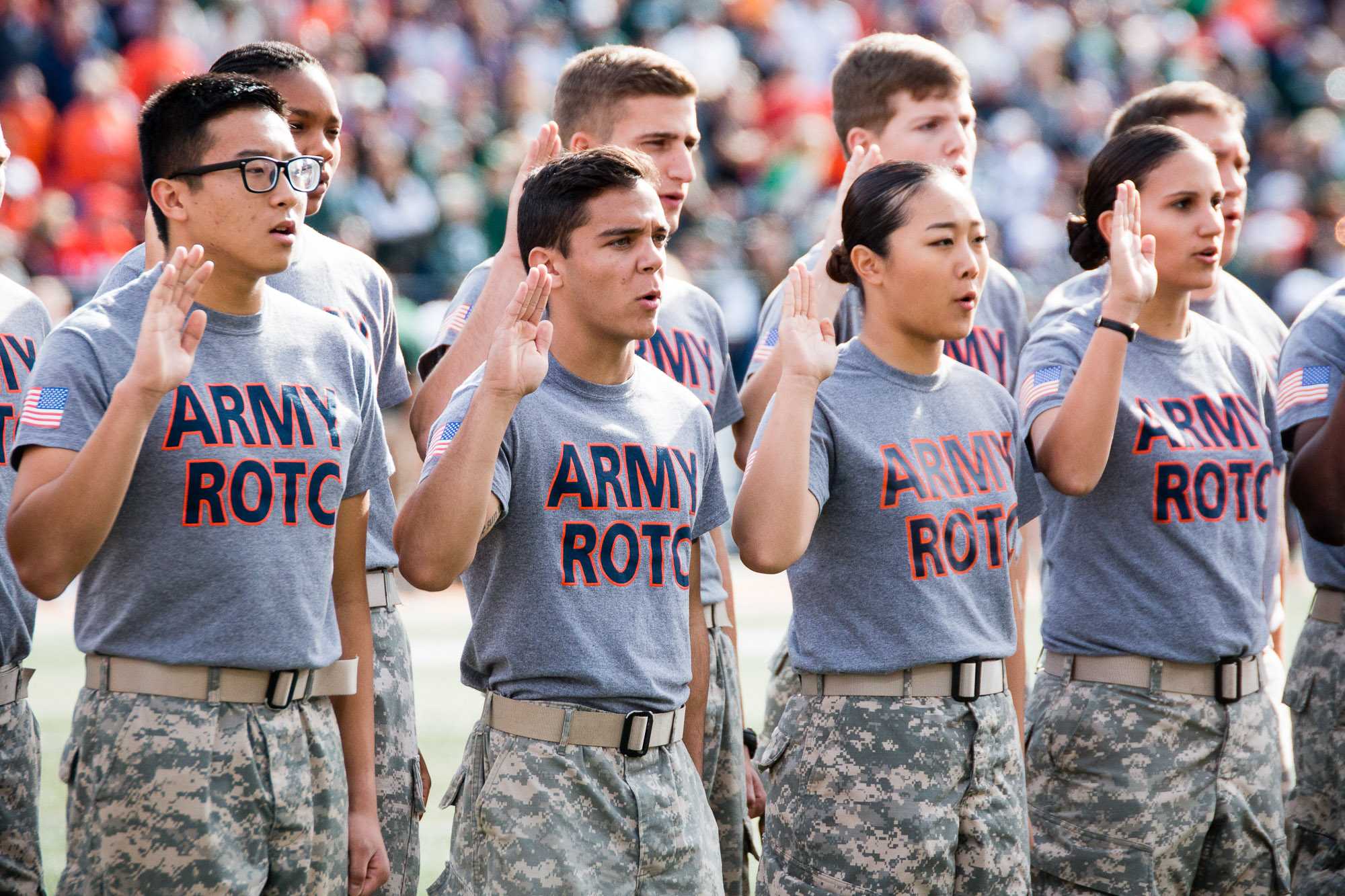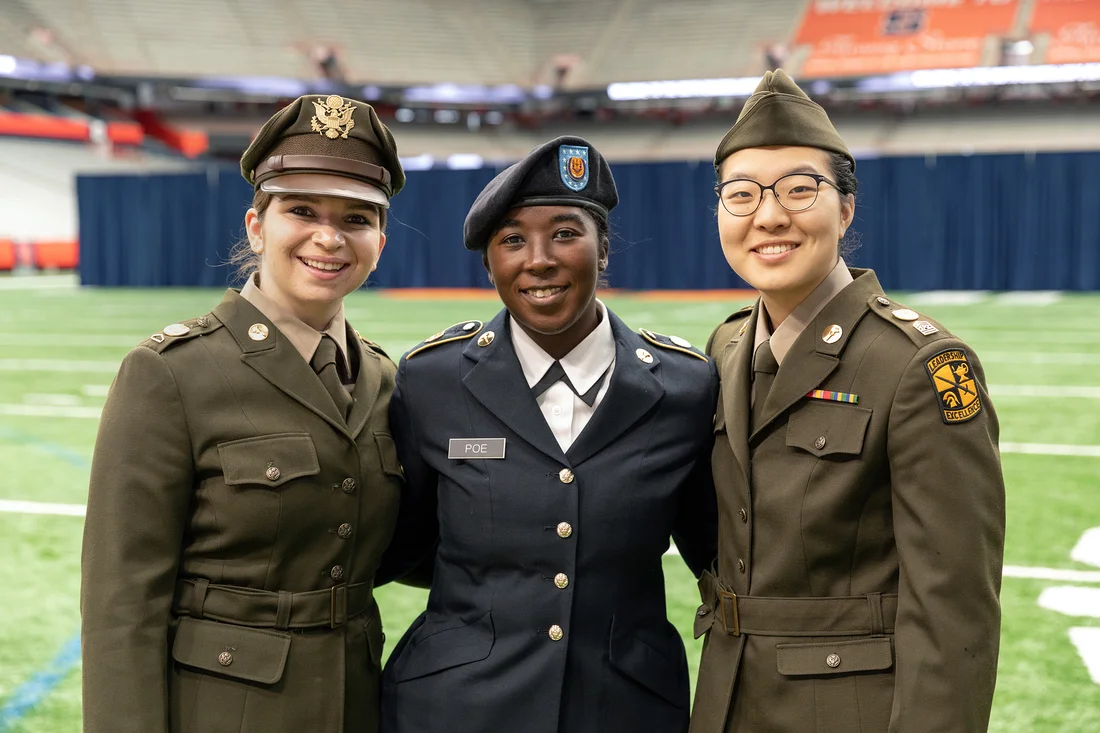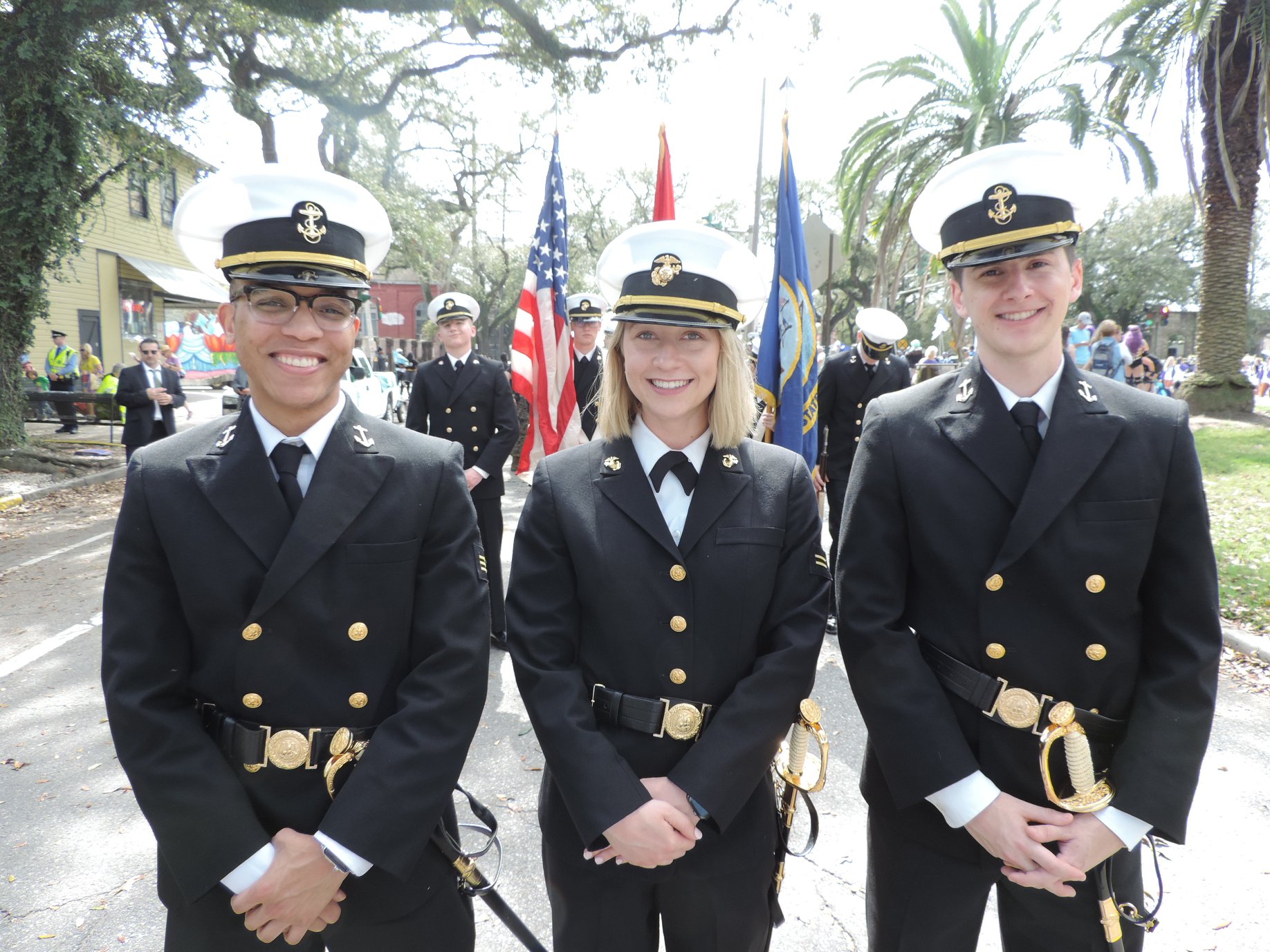Adrianne is a college admissions consultant and TV/film director, producer, writer, and actress currently based in LA. She uses her experience in multiple disciplines to help students achieve their personal and academic goals.
Many students have heard of ROTC or may have seen recruiters at college fairs, but they may not have heard of the different opportunities these programs provide, from scholarship benefits to leadership development, in exchange for military service upon graduation. Read on to see if ROTC is a fit for you or your student!

Army ROTC students at the University of Illinois
As high school students and their parents embark on the journey of selecting the right college or university, many might be drawn to the idea of combining higher education with military training and leadership development. The Reserve Officers’ Training Corps (ROTC) offers a unique opportunity for students to pursue their academic goals while preparing for a future career in the armed forces.
In this article, we will delve into the different options for ROTC programs at colleges and universities across the United States, helping you make an informed decision about this valuable path to service and leadership.
.
Table of Contents
What is ROTC?
The Reserve Officers’ Training Corps (ROTC) is a program designed to produce officers for the United States military. It’s available at more than 1,700 colleges and universities throughout the country and can often cover participants’ college tuition in exchange for a service commitment.
The program is designed to teach students leadership skills, military skills, and the values necessary to become officers in the U.S. military. While many people associate ROTC primarily with the Army, there are also programs for the U.S. Air Force, Navy, and Marine Corps.
Let’s explore the different options available for college students interested in the Reserve Officers’ Training Corps.
1. Army ROTC
The Army ROTC program is the largest and oldest of the ROTC branches, and it offers the most opportunities for students to participate. Students in Army ROTC can choose from a wide variety of majors and pursue both undergraduate and graduate degrees. The program is known for its rigorous physical training sessions, leadership development, and great Army ROTC scholarship opportunities.
Additionally, Army ROTC offers the Simultaneous Membership Program (SMP), which allows cadets to perform active service in the Army National Guard or Army Reserve while completing their education.
2. Air Force ROTC
Air Force ROTC is another excellent option for students interested in careers in aviation, space, or related fields. This program is offered at over 145 colleges and universities nationwide. Students can choose between two tracks: the General Military Course (GMC) for freshmen and sophomores, and the Professional Officer Course (POC) for juniors and seniors.
Air Force ROTC emphasizes leadership, physical fitness, and aerospace education, preparing cadets for various career opportunities in the U.S. Air Force.
3. Navy ROTC
Navy ROTC and Marine Corps ROTC programs are offered at select colleges and universities. Navy ROTC focuses on preparing students for careers in the U.S. Navy, while Marine Corps ROTC trains cadets for service in the Marine Corps. Securing a Navy ROTC Scholarship can grant you the chance to gain valuable experience on naval vessels and Marine units while developing your leadership abilities.
If you have a strong interest in maritime affairs or a desire to serve at sea, Navy or Marine Corps ROTC may be the right choice for you.
4. Coast Guard JROTC
While Coast Guard ROTC programs are less common and differ slightly from the other branches’ programs, they still provide an excellent opportunity for students interested in protecting U.S. waters and maritime interests. The Coast Guard ROTC program is offered at select schools, and it focuses on developing leaders for the U.S. Coast Guard.
Cadets in this program receive a unique education that combines traditional academic coursework with specialized training in maritime operations and law enforcement.
Choosing the right ROTC program is a significant decision that requires careful consideration. Here are some factors to keep in mind when making your choice:
- Branch of Service: Consider which branch of the military aligns with your interests and career goals. Each branch has its unique culture and mission.
- College or University: Research the schools that offer ROTC programs in your preferred branch and assess their academic programs, campus culture, and location.
- Scholarships and Financial Aid: Explore the scholarship opportunities offered by each program and assess their financial benefits.
- Program Structure: Understand the structure of the ROTC program at each school, including the level of training intensity, the availability of specialized training opportunities, and any unique features.
- Commitment: Think about the long-term commitment required after graduation, as well as your willingness and ability to meet it.
.

Air Force ROTC and Army ROTC students at Syracuse University
.
Scholarships and Financial Aid
One of the most attractive aspects of ROTC programs is the scholarship program and financial support they offer to students who are interested in U.S. military service after graduation. Each military branch of ROTC provides scholarships that cover tuition, fees, and textbooks for recipients. These scholarships can significantly ease the financial burden of attending college. Additionally, students may receive a monthly stipend to help with living expenses.
The scholarship application process is competitive and typically involves meeting academic, physical fitness, and leadership criteria. Additionally, scholarship recipients commit to serving in the military after their college graduation, usually for a minimum of four years. It’s important to consider the long-term implications of this service obligation when deciding whether or not ROTC is a fit for you.
Here are the primary types of scholarships available for ROTC students in college:
- Four-Year Scholarships: These scholarships are typically awarded to high school seniors who plan to enroll in an ROTC program at a college or university. They cover full tuition and fees, provide a textbook allowance, and include a monthly stipend. 4-year scholarships are highly competitive and require scholarship applicants to meet the highest academic and physical fitness standards.
- Three-Year Scholarships: Three-year college scholarships are available to college freshmen or sophomores who are already enrolled in an ROTC program. Like the four-year scholarships, they cover tuition and fees, provide a textbook allowance, and include a monthly stipend. The application process for three-year scholarships is also competitive.
- Two-Year Scholarships: These scholarships are designed for college juniors or transfer students who commit to two years of ROTC participation. They cover tuition and fees for the remaining two years of college, provide a textbook allowance, and include a monthly living stipend.
- Advanced Standing Scholarships: Advanced Standing Scholarships are typically awarded to cadets who have completed the basic ROTC coursework and have been selected for an advanced training program. These scholarships often cover tuition, fees, and provide a monthly stipend for the duration of the advanced training.
- Room and Board Scholarships: In addition to tuition and fees, some ROTC programs offer scholarships that cover room and board expenses for students who live on campus. These scholarships can significantly reduce the overall cost of attending college.
- Dedicated Major Scholarships: Certain ROTC programs may offer scholarships that are specific to particular majors or fields of study. These scholarships aim to attract students with skills and expertise in areas that are in demand within the military.
- Summer Training Opportunities: While not traditional scholarships, some ROTC programs provide cadets with opportunities for paid summer training, internships, or experiences. These programs allow cadets to gain valuable skills and knowledge while earning money for their education.
It’s important to note that ROTC scholarships come with certain obligations. Recipients of these scholarships commit to serving in the U.S. military after graduation, typically for a specified period, which can range from three to eight years, depending on the branch and program. Cadets must also meet academic and physical fitness requirements to maintain their scholarship eligibility.
To apply for ROTC scholarships, students should contact the specific ROTC program they are interested in or visit the official websites of the respective branches (e.g., Army ROTC, Air Force ROTC, Navy ROTC, Marine Corps ROTC) for detailed information on eligibility criteria, application deadlines, and application procedures. Additionally, speaking with a college’s financial aid office and the ROTC program’s staff can provide valuable guidance and assistance throughout the application process.
..

.
A Day in the Life of an ROTC student
ROTC programs are rigorous and require a significant time commitment. Cadets participate in military training exercises, physical fitness routines, and leadership development activities alongside their regular academic coursework. The intensity of the training varies depending on the branch and program level.
The daily schedule of a college student participating in ROTC can vary depending on the specific branch of ROTC — Army ROTC, Air Force ROTC, Navy ROTC, Marine Corps ROTC, or Coast Guard ROTC — and the level of participation, i.e. freshman/sophomore versus junior/senior.
However, here is a general overview of what a typical day for an ROTC cadet might look like:
- Physical Training (PT): Most ROTC programs incorporate regular physical training sessions into their schedules, often held in the early morning. PT sessions focus on improving physical fitness, including cardiovascular endurance, strength, and overall conditioning. Cadets engage in activities such as running, calisthenics, strength training, and obstacle courses.
- Military Science Classes: Cadets attend military science courses, which are typically part of their academic curriculum. These classes cover topics such as leadership, tactics, military history, and military ethics. Students learn essential military knowledge and skills during these classes.
- Leadership Labs: Many ROTC programs hold weekly or bi-weekly leadership labs. Leadership labs provide hands-on training in military skills and leadership, often involving practical exercises, drills, and teamwork. Cadets may practice navigation, weapons handling, first aid, and other essential military tasks during these sessions.
- Uniform Wear: Cadets are required to wear their ROTC uniforms on designated days. Uniform days might include class days, leadership labs, and special events. Proper uniform wear and appearance are emphasized.
- Academic Classes: In addition to military science courses, cadets attend regular academic classes as part of their chosen major. Time management is crucial for balancing ROTC commitments with academic coursework.
- Leadership Positions: Cadets may have opportunities to hold leadership positions within their ROTC unit, such as squad leader or platoon leader. Leadership roles come with responsibilities that require effective communication, decision-making, and teamwork.
- Special Training and Events: ROTC cadets often participate in special training events and activities, such as field exercises, marksmanship training, and military simulations. These events may occur on weekends or during school breaks.
- Mentorship and Advising: Cadets typically have access to ROTC cadre (military instructors) who provide guidance, mentorship, and advice on academic and military matters. This helps cadets seek assistance in navigating their ROTC journey.
- Community Service and Outreach: Many ROTC programs emphasize community service and engagement. Cadets may be involved in volunteering or outreach activities to connect with their local communities.
.
Career Opportunities
As mentioned above, ROTC programs provide a pathway to becoming an officer in the U.S. military. Upon successful completion of the program and graduation from college, ROTC cadets are commissioned as officers in their respective branches. As officers, they hold leadership positions and are responsible for the well-being of their subordinates and the accomplishment of their mission.
In addition to leadership roles within the military, ROTC graduates often find success in civilian careers as well. The leadership, discipline, and problem-solving skills acquired through ROTC can be valuable assets in various professions, including business, healthcare, and government.
ROTC graduates are not limited to military careers. The leadership, discipline, and problem-solving skills they acquire can be valuable in various civilian professions, including business, government, and healthcare.
.

Navy ROTC students at Tulane University
ROTC programs offer a valuable path to both higher education and a future in the U.S. military. By exploring the different options available, considering scholarship opportunities, and assessing your career goals and commitment level, you can make an informed decision about which ROTC program aligns best with your aspirations.
Remember that ROTC is not just a commitment to serve; it’s also an opportunity for personal growth, leadership development, and a meaningful contribution to the defense of our nation.
.
Want to stay up to date on the latest news in college admissions, or need help with your college applications? You can subscribe to our newsletter or schedule a free consultation with one of our admissions consultants.



